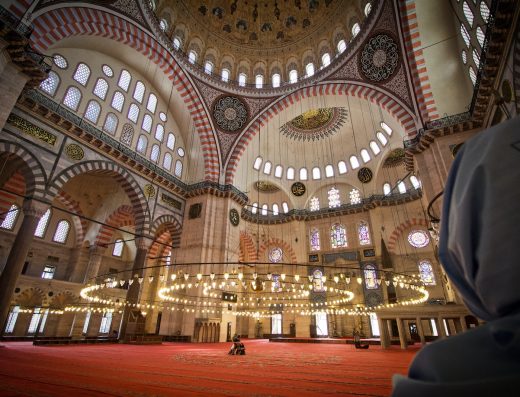Beneath the bustling streets of Istanbul, a hidden world of columns and water unfolds in the Yerebatan Sarnıcı, or the Basilica Cistern, one of the city’s most fascinating historical marvels. Stepping inside is like entering a dreamlike underworld where Byzantine engineering meets a timeless, mystical ambiance.
Built in 532 CE during the reign of Emperor Justinian I, the cistern was part of an ambitious project to secure Constantinople’s water supply. It stored and transported water via aqueducts from the Belgrade Forest, ensuring the city’s survival during times of siege and drought. Its name, “Basilica Cistern,” derives from the grand Roman basilica that once stood above it.
The cistern is an architectural wonder, covering an area of 9,800 square meters with a capacity of approximately 80,000 cubic meters of water. Its most enchanting feature is its 336 marble columns, each standing 9 meters tall and arranged in 12 rows. As you wander through its dimly lit pathways, reflections shimmer on the water below, creating a surreal, almost magical effect.
Among the cistern’s most famous features are the two Medusa heads, repurposed as column bases. One lies upside down, and the other on its side, their origins and positioning shrouded in mystery. These relics, likely taken from ancient Roman ruins, add an element of myth to the cistern’s already mesmerizing atmosphere.
The Yerebatan Sarnıcı was forgotten for centuries after the Byzantine era, rediscovered during Ottoman times when locals reported fishermen drawing water – and fish – from their wells. It was restored and opened to visitors in the mid-20th century and has since become one of Istanbul’s most iconic attractions.
In recent years, the cistern has been enhanced with modern lighting and occasional cultural events, such as concerts and art exhibitions, transforming it into both a historical and artistic hub. Standing amidst its forest of columns, you can feel the weight of history, the whispers of the past, and the ingenious spirit of its creators.
A visit to the Basilica Cistern is not just a journey beneath the surface of Istanbul; it’s a plunge into a world where history and myth intertwine, leaving an indelible mark on all who enter.
İstanbul’un hareketli sokaklarının altında, Yerebatan Sarnıcı ya da diğer adıyla Bazilika Sarnıcı, sizi geçmişin büyüleyici dünyasına davet ediyor. Bu yeraltı sarayı, Bizans mühendisliğinin hayranlık uyandıran bir örneği olarak, mistik bir atmosfer içinde ziyaretçilerini büyüler.
532 yılında, İmparator Justinianus döneminde inşa edilen Yerebatan Sarnıcı, Konstantinopolis’in su ihtiyacını karşılamak için tasarlanmış büyük bir projeydi. Su, Belgrad Ormanları’ndan gelen su yollarıyla buraya taşınır ve şehirdeki kuşatmalar veya kuraklık dönemlerinde hayati bir rol oynardı. Sarnıcın adı, üstünde yer alan Roma dönemine ait büyük bir bazilikadan gelir.
9,800 metrekarelik bir alanı kaplayan sarnıç, yaklaşık 80,000 metreküp su depolama kapasitesine sahiptir. Ancak onu bu kadar eşsiz yapan, 12 sıra halinde düzenlenmiş ve her biri 9 metre yüksekliğindeki 336 mermer sütunudur. Zayıf bir ışıklandırma altında, su yüzeyindeki yansımalar sarnıca büyülü bir hava katar.
Sarnıcın en dikkat çekici özelliklerinden biri, iki Medusa başıdır. Bu başlıklar sütun tabanı olarak kullanılmış ve biri ters, diğeri yana dönük şekilde yerleştirilmiştir. Antik Roma kalıntılarından getirildiği düşünülen bu başlıkların anlamı ve yerleşim şekli hâlâ bir sır olarak kalmaktadır. Mitolojik çağrışımları, sarnıcın etkileyici atmosferini daha da güçlendirir.
Bizans döneminden sonra uzun yıllar unutulan Yerebatan Sarnıcı, Osmanlı zamanında yerel halkın kuyulardan su ve balık çekmesiyle tekrar keşfedildi. 20. yüzyılın ortalarında restore edilerek ziyaretçilere açılan sarnıç, bugün İstanbul’un en önemli simgelerinden biri haline gelmiştir.
Son yıllarda modern aydınlatma sistemleri ve zaman zaman düzenlenen konserler ve sergilerle sarnıç, hem tarihî hem de sanatsal bir merkez hâline gelmiştir. Bu görkemli sütunlar arasında dolaşırken, tarihin yükünü, geçmişin fısıltılarını ve mühendislik dahisinin izlerini hissedersiniz.
Yerebatan Sarnıcı’nı ziyaret etmek, yalnızca İstanbul’un yüzeyinin altına inmek değil; tarih ve mitolojinin iç içe geçtiği, büyüleyici bir dünyaya adım atmaktır.









